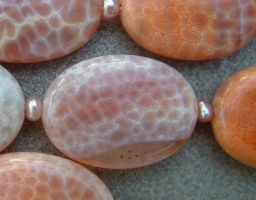»Snakeskin Agate«
Since many years the trade name »Snakeskin Agate« applies for a beige chalcedony with characteristic white lines. (fig. 1).
In 2005, very similar looking material in bright orange colors appeared on mineral fairs, being sold by Chinese retailers as "Fire Agate". But this labelling is absolutely wrong and misleading.
»Fire Agate«
Genuine »Fire Agate« is a brown and often kidney-shaped chalcedony, which strikes with colorful iridescent areas where light is reflected on thin iron oxide plattlets and films (fig. 2).
The idea, that the play of color may derive from thin opal layers has been ruled out a long time ago (Gübelin, 1979, Lapis 4/12).
Deposits of »Fire Agate« are located in Mexico and the USA, where it occurs naturally as stalactites and nodular structures in cavities of volcanic rocks. In contrast to this, the orange colored "Snake Skin" agate is a product of the art of dyeing and heating.
»Fire Carnelian« / dyed »Snakeskin Agate«
Initially natural Carnelians were heated to a temperature, where the chemical integrity starts to get destroyed and water leaves the lattice structure along cracks and fissures. The result is a striking white pattern that resembles a spider's web or a snakeskin (fig. 3).
These stones were introduced into the market as »Fire Carnelian«. With increasing demand, artificially dyed agate was treated the same way and sold as »Snakeskin Agate«. This color treatment has to be explicitly declared.
The correct term for this material is: "Snakeskin Agate (dyed)".






